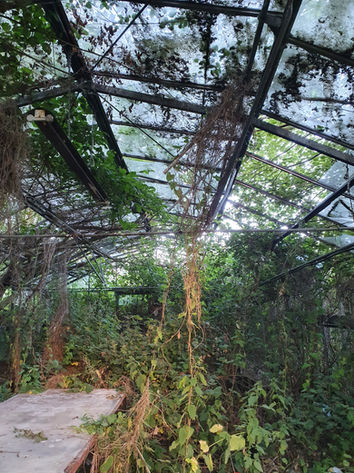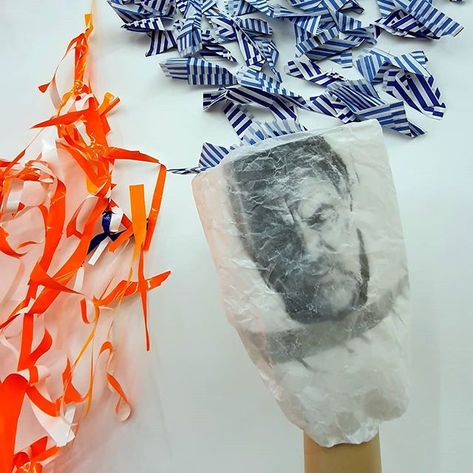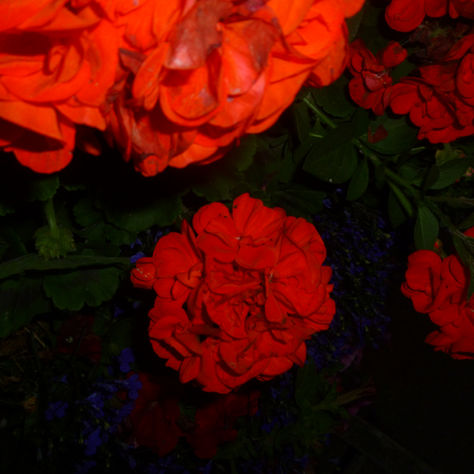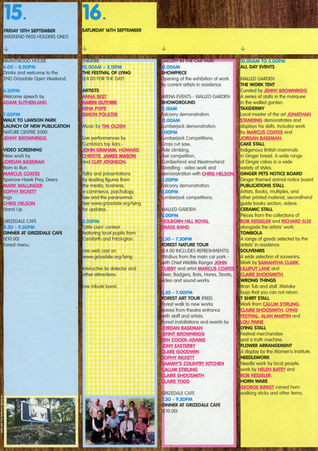Claire Shoosmith

Mint House, Pevensey 2024

Towner Gallery Open Plan Summer School, Eastbourne 2022
Tutt's Barn, 2020 - 2022
Closed for 13 years, this nursery had fallen deep into dereliction. Unable to bear the pressure of keeping the business afloat the owner locked the gate and walked away. The extended lockdown had released nature to climb, twist and grip the buildings in a stranglehold of bindweed, bramble and ivy. Creatures scurry in the undergrowth and new ecosystems developed to support rare species.
The impenetrable guard of nature has, over the years, provided a sanctuary for wildlife but has also shielded a continuous trade in drugs culminating earlier this year in the discovery of a hidden cannabis farm.
I spent two years working in the nursery with a group of volunteers to gently reclaim the glasshouses for local food production while safeguarding the wildness. We worked to rebuild the nursery as an area of 'common land' questioning the traditional idea of ownership.
In 2022 the volunteers were evicted, the site's perimeter fencing strengthened and once again left to the drug dealers. We can only presume that the owners are waiting/hoping for the increased demand for housing land to claim this flood prone site and give it monetary value.
Lockdown, 2020
During lockdown, I walked the streets of Eastbourne counting elm trees in the throes of death. The latest victims, bark freshly stripped bare, limbs sliced back to the trunk with flesh still warm, orange almost breathing, and the grey stumps that stand as a reminder of what has passed, markers of time.
The ‘girdling’ reveals anthropomorphic skin. Pores, blemishes, scars of a life lived long enough to hold the memory of past epidemics. My reaction is visceral, I know that this has to be done to prevent the disease from spreading but staring each death in the face – the sudden catastrophic end of a tree struggling to survive stands as a harbinger of our times.
As my thoughts transitioned from counting trees to trying to comprehend the daily covid statistics, images of the vulnerable people I knew and had photographed in happier times fell into my head and became inextricably linked with the trees.
In the images, it becomes hard to differentiate between the heartwood laid bare and the human skin, drawing attention to our shared cellular physiology and the interconnected nature of our existence in life and death.
This work continues my exploration of how we react to life-changing events, the split second – the breath – between life and death. Controlling chaos, coping with emergencies, keeping hold of memories, and letting go. This pandemic has been all about that breath, focusing our minds as never before on the mechanisms that keep us alive.

The Weald & Downland Museum, Chichester 2020
Towner Gallery, Eastbourne 2019
As part of Towner’s ‘Art School’ programme I had the opportunity to spend seven days working in a clear, white-walled gallery space. Away from the distracting accumulation of stuff in my home studio, I worked with a limited range of mainly ephemeral materials to create prints, collages, and 3D assemblages.
The public were welcome to visit and chat with the artists throughout the day and I invited the visitors to collaborate in the work by having their photographs taken with their eyes open and then with their eyes shut. Every day I mixed and manipulated the pieces to create a new composition growing in scale across the gallery walls.
Standard Issue Zine: 27 Collages, 2019
Collage selected for page number 2 of the Standard Edition artzine curated by Simon Barker and distributed from the Towner Gallery.
Installation, Curious Projects Studio, Eastbourne 2016
How does our memory play tricks on us? If we hear a story often enough can it make it seem true? The Dutch author J Bernlef’s 2003 novel 'Outside It’s Monday' is an ode to memory. You cannot live without memories, believes the main character "When someone’s no longer here, memories are the only thing left, so you cherish them, try to prevent them from fading away."
Memories lay gently one on top of another like the sedimentation of clay in a riverbed, over time they become compacted and distorted. Although the layers are still visible the order becomes confused and the stories lost or exaggerated.
For this installation, I captured a voice recording, repeating a story over and over in a pair of clay vessels, one talking and the other listening.
Blue Monkey Network residency, Eastbourne College 2014
Herbert Cole writes in ‘I am not myself – the art of African masquerade’, – "the masker neither talks nor acts like a true human, and as he careers wildly through the village seems to be outside human laws".
This residency took place when I had recently arrived back in the UK after five years in France. Feeling yet again 'out of place' I was more acutely aware of how we respond to strangers and strange situations. When we are presented with behaviour that we find hard to comprehend, how do we react?
Looking at the tipping point between nonchalant acceptance and mistrust, I developed work that explored the narrative of a character who is gradually losing their ability to operate 'normally' in society.
https://bluemonkeysharedspace.wordpress.com/claire-shoosmith/
Site specific installations, community collaboration & events, Grizedale 1999-2001
I spent a lot of time wandering round the forest, sometimes - rarely - passing a group of visitors eavesdropping on their conversation. It's not the wilderness but it is remote, quiet, lonely and the more days spent alone the more I felt the need to connect with people.
The start of my residency was unusual, not only was I alone during the day - no other residents arrived for a couple of weeks - I also spent my evenings alone in the - then - very odd 8 bed ex. guest house that was used for the Grizedale artists. I think a slight madness came over me.
I started making jumpers out of cut-up walking socks, covering them in sew-on badges of mainly Cumbrian tourist spots. I thought at the time it was a reflection on the nature of tourism, the difference between belonging in a place and visiting a place, now I realise I made them as a device for getting out and connecting with people.
I travelled to almost every badge location and started conversations that usually ended up with me photographing the people I met wearing one of the jumpers. I designed an embroidered badge to add to the jumpers simply stating 'Great view' that was made as a multiple to sell in the Grizedale shop.
I might digitize my analogue images and make a separate website that celebrates these chance encounters and maybe tries to connect with some of the people in the photographs.
I spent 3 years off and on at Grizedale, making work, cooking, producing and co-curating events.

















































































